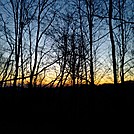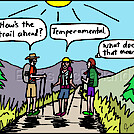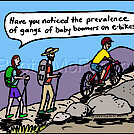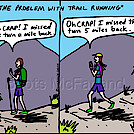In this age of multi-tasking, miniaturization, and more gearthan ever, super-lightweight binoculars are in high demand
Diana Doyle • Minneapolis, Minnesota
Are you a brunner? A birker? Many of us bird while doing other outdoor activities, such as trail running (“brunning”) or biking (“birking”). I haven’t yet seen portmanteaus for skiing-birding, backpacking-birding, or canoeing-birding, but I’ve seen you out there. We venture outdoors for exercise or recreation, yet we never stop birding. But what about those pesky binoculars? If you’ve ever tried to trail-run or ski with binoculars clanging on your chest, or ruined a pair by driving road grit into the focus wheel while biking, or schlepped two-pounders up a summit ascent, you know what I’m talking about. It’s tempting to leave them at home or in the car. In the game of birding, though, there’s always that chance of sighting something eye-catching or unusual. Is that a male Cerulean Warbler right overhead? Might that off-color thrasher be an out-of-range notable? You’ll never know, because you left your binoculars at home.
Lighter than an iPhone
As I prepared for hiking in the Adirondacks High Peaks, I considered my beloved binoculars. They weigh more than 1½ pounds—in a culture that trims handles off toothbrush-es to save mere grams. I needed another strategy, because visiting the alpine habitat of Bicknell’s Thrush without binoculars was not an option.
So out of curiosity, and necessity, I searched for the lightest binoculars available. Optics manufacturers have pushed the engineering down to impressively minimal weights. How about a pair of Leica or Zeiss for less than nine ounces? I suppose I shouldn’t be surprised,
with the trend toward everything going smaller and lighter. In fact, Zeiss has had an ultra-light binocular since the 1990s, the 10x25 Design Selection Compact, weighing only seven ounces. For nearly 20 years, this has been the preferred primary binocular of ABA Checklist Committee Chair Bill Pranty.
Before we delve into manufacturers and models, let’s get a sense of how small is small. For this article, I arbitrarily capped the weight at 10 ounces because there are so many choices. These binoculars are often classified as “compact,” but they should really be considered “mini.” They are typically 8x22± or 10x25±, rather than the usual 8x42 or 10x42. Sized at about 4”x4”, they range from seven ounces to 10 ounces—about 1/3 to 1/2 the weight of typical full-sized birding binoculars. If you’re willing to bump up a bit on the weight, there are even more choices. Zeiss Terra ED, Kowa BD, and Vortex Viper are under 12 ounces. The Swarovski CL Pocket and Vortex Diamondback are under 14 ounces.
For comparison, my iPhone 6 with protective case weighs six ounces and measures a bit under 3”x6”. So if you can carry a smartphone while running, skiing, hiking, or biking, you can carry mini-binoculars.
Plenty of Choices
Several optics companies have jumped into the ultra-light competition, including such highly respected names as Bushnell, Kowa, Leica, Minox, Nikon, Steiner, and Zeiss.
When choosing a model, don’t simply default to the lightest pair. In fact, the manufacturers’ stated weight may not be as listed, due to modifications in design or manufacturing variability. Both the Nikon Trailblazer and Bushnell Off Trail, for example, have discrepancies in weights between brochures and online specs. Then again, we’re shaving tenths of ounces at this point, so 9.9 oz. vs. 10.5 oz. doesn’t matter much.
Lessons Learned
Is a 10-ounce binocular worth its weight? While backpacking I tested several of the models listed in the accompanying table (below). In the end I decided that if you don’t want to lug “regular” binoculars, these mini binoculars are absolutely better than going naked. But they take practice and some forgiveness, and I’ve learned some tricks.
First, consider omitting the strap. These bins are small enough to fit in a pocket, including a shorts pocket or backpack drink pocket. Although the strap adds negligible weight, it tangles up with your pocket when you try to do a quick-draw. These bins are supposed to be lean, so make them that way. Consider jettisoning the case and caps, instead wrapping the bins in a double-duty bandana for extra protection if needed.
If you want to wear the bins around your neck, then shorten the strap as much as possible. Make the strap only long enough for the eye pieces to precisely reach your eyes. A very short strap minimizes side-swinging and torso-tapping while hiking, biking, running, or skiing.
With the ergonomics set, the next step is adjusting to such small optics. I initially struggled with three related challenges: use with eyeglasses, the small field of view, and use in low light.
The magnification, at 8x to 10x, is the same as for typical birding binoculars. However, the objective lenses, at 20–25mm, are much smaller than we’re accustomed to. Smaller objective lenses have two implications: the field of view is small, and less light is admitted.
A small field of view makes it harder to target the bird. This is a problem that can be overcome with practice. Once you get on the bird, at 8x or 10x you have the same magnification as with your big bins.
Ultra-lightweight binoculars, with smaller objective lenses, can’t bring in light like a full-sized pair. It’s not reasonable from an engineering standpoint to expect the light transmission rates of full-size optics. So mini-bins work best in bright conditions, better for nordic skiing in snowy sunshine than hiking dark northern woods.
The use of eyeglasses compounds both of these compromises. The eye relief needed for eyeglasses makes the field of view even smaller. Eyeglasses are an additional intervening lens, which further reduces the brightness and clarity of the image. And unless you’re in sunny and snowy Colorado, sunglasses + mini-binoculars is a non-starter. Mini-bins can’t afford to sacrifice more light with tinted glasses.
I ultimately discovered a compromise as an eyeglass- or sunglass-wearer. In dark settings, I adjust the diopter and set the eye cups up for bare-eye viewing, and flip my eyeglasses up to my forehead when viewing.
Despite these caveats, I find that having mini-binoculars is much better than no binoculars at all—in fact, 8–10x better. They work fine when it comes to seeing the field marks of a Boreal Chickadee and separating a Ruby-crowned vs. Golden-crowned kinglet.
They won’t replace my primary binoculars, though. Whenever I can endure the weight and encumbrance of regular binoculars, I’ll take them for the brightness and wide field of view. But binoculars under 10 ounces are excellent special-purpose optics, when light weight and small size are essential. I’ve given the examples of trail running or weightconscious backpacking, but there are others. For as little as
$100 you may find it worth filling this niche with a pair of minis. Who knows? You may even fall in love with the light weight and convenience, opting to invest in one of the premium pairs as your primary pair. As with the evolution of our computers and laptops, a lightweight binocular doesn’t mean a lightweight birder.
Nearly all digital cameras now include image stabilization, also called vibration reduction. So why aren’t we all using image-stabilizing binoculars? I often receive questions about “IS bins,” with the underlying premise that image-stabilizing binoculars are a panacea—if only one could afford them. Well, they’re now affordable, but are you seeing them in the field? No, and here’s why.
I had the opportunity to test several IS binoculars from the leading manufacturers. They were an assortment of models, ranging in price from $300 to $1,500, from compact to full size, from 10x to 14x. I tried them on land and at sea. I won’t keep you in suspense: The technology is there, but not for birding.
From an engineering perspective, they work as advertised. An internal gyroscope engages, steadying the image and locking it rock-steady. But if you move the bins too much—for example, to jump from bird to bird in a wake-trailing flock, the gyroscope gets confused. Any fast movement on your part sets the gyroscope awry, blowing your two-second chance on that flyby Little Gull. These are slow-and-steady optics, not ready for fast-action birding.
Note that IS binoculars tend toward high magnification, typically 14–16x instead of the usual 7–10x of traditional birding binoculars. The premise is that image stabilization compensates for the difficulty of steadying the higher magnification.
Unfortunately, IS bins also tend toward very small objective lenses, resulting in a correspondingly narrow field of view. The word “pinpoint” comes to mind. On all the models I tested, I felt like I was looking through a tiny hole, making it difficult to target and stay on a moving bird, even at sea with large seabirds.
Despite having a slew of IS binoculars on hand, I found myself wanting my plain-old birding binoculars, whether I was birding at sea, birding on foot, or birding by car. I strongly prefer the wide field of view, bright and true colors, and fine-detailed images of larger bins. If forced to use IS bins, I’d opt for one of the smaller, lighter, lower-magnification models, which fortunately also tend to be less expensive.
So, if you wonder why you’re not seeing IS binoculars displayed at birding trade shows, the optics reps may be onto something. In my opinion, IS bins are not a mainstream birding binocular. Maybe you’ve had a different experience with IS binoculars, perhaps to compensate for a medically related hand tremor. If so, share your experiences in an online forum hosted by Birding and the ABA: publications.aba.org.



 Departments
Departments
 Click here to order
Click here to order













 Currently Active Users
Currently Active Users
 Recent Threads
Recent Threads
